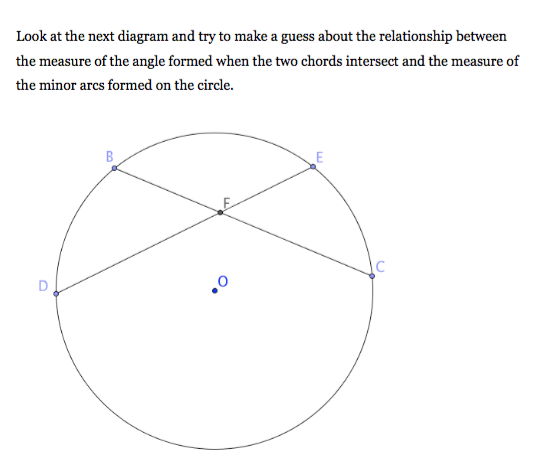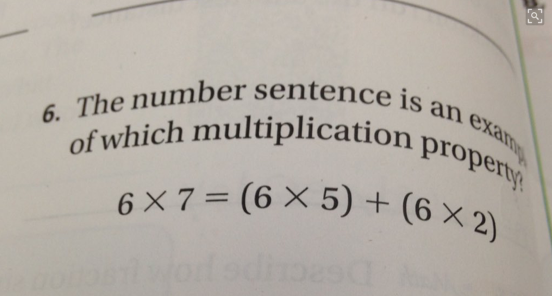Neither of the qualities in the title of this post are apparent in abundance at this time of the school year (exams here start on May 21!!!) so I am especially pleased to be able to write about today in my two Geometry classes. They each took a quiz with me in their last class and I asked them to read ahead to the next section (more on that later) before meeting again today. After a brief warm up we reviewed the quiz and I returned papers. Then I presented them with this image from our Geometry text

Now, at this point we have established that the measure of a central angle in degrees is equal to the measure of its intercepted arc in degrees. We have proven that the measure of an inscribed angle in degrees is half of the measure of its intercepted arc in degrees. I told them that my dream for today was to derive some formula relating the measure of angle EFC to some combination of the arcs BE, EC, CD, and DB. I reminded them of what we already know and suggested that using what we already know is often pretty helpful when trying to learn something new. I then stepped back and let kids toss out ideas. In one of the two classes I took a walk to the water fountain and popped in on a colleague for a two minute chat. I came back into a room with people debating and waving their hands in the air to show what segments they wanted to draw. I wish I saw more drawing at their desks, but it was good engagement. In both classes they wanted me to name the vertical angle pairs at the hinge point F. I was a bit surprised that neither group wanted to name arcs yet, but it worked out just fine. I dropped a hint that another segment drawn would help and this spurred some lively debate about what segments to draw. BE and DC were popular but I pointed out that the vertical angles were not included really in these triangles that were formed. Some folks wanted some radii drawn. One girl was sad when we named our vertical angle pairs. She saw that BFE and DFC were clearly equal but that they faced arcs that clearly weren’t. I was pleased by this observation. There was a real desire in each class to assume that BD and EC were equal and I wish my diagram was more clearly designed to discourage that. We finally settled on drawing the chord BD which created two inscribed angles that we called x and y creating arcs called 2x and 2y. The heavy lifting and guessing were done by that point. Arriving at the conclusion that we now need a relationship between one angle and two arcs came in a couple of steps. In both classes I made a clear statement about what we just discovered and they seemed pretty pleased with themselves, if a bit tired from the exertion. In my morning class we were on our 90 minute block and I gave them some practice exercises that we will revisit tomorrow. In my afternoon class that ended the day we simply left the discovery on the board. I start tomorrow morning with that crew and I am excited to pick this up again.
In each of my classes I have 14 students. One was absent today, so I had 27 overall joining in on this conversation. One of them, when I mentioned my dream for the day, said ‘In the reading last night it said that this angle is the average of two arcs.’ [Thank you Niko!]
One student. Now, it is entirely possible that other students did the reading I requested. It is possible that some read the section and were confused by it. It is possible that some read it and forgot the conclusion. It is possible that some who read it simply did not feel like saying anything out loud. It feels more likely that few (maybe only 1?!?) did the reading.
I could dwell on that, but I am dwelling on the discovery we made. I am dwelling on the persistence and patience of my students today. I am dwelling on what went right to end a day that started poorly for me.
Later, I’ll dwell on how I can help overcome the likely habits of not reading that I am faced with. I’ll save that for a less beautiful day than today.


